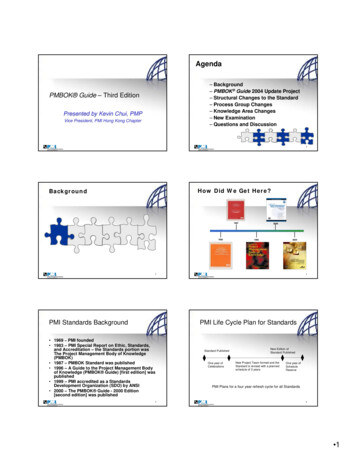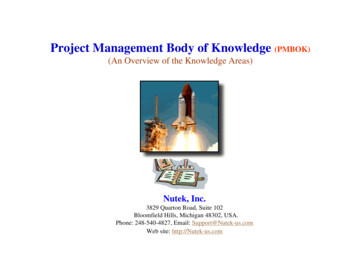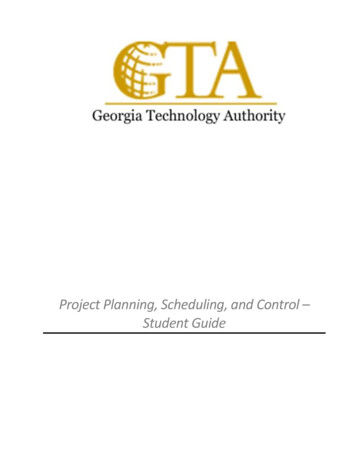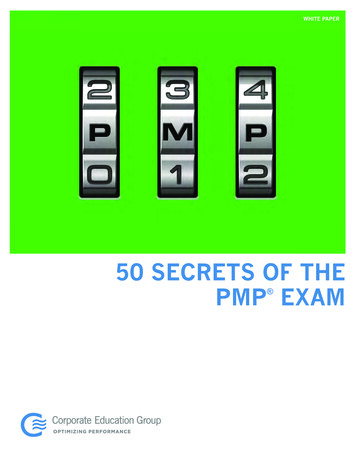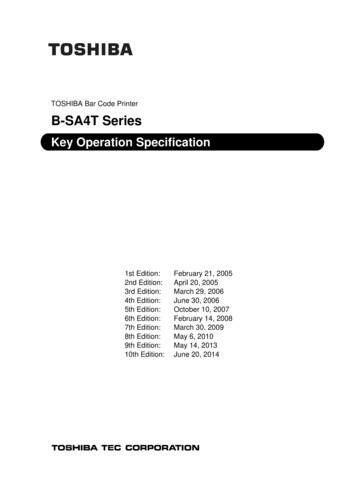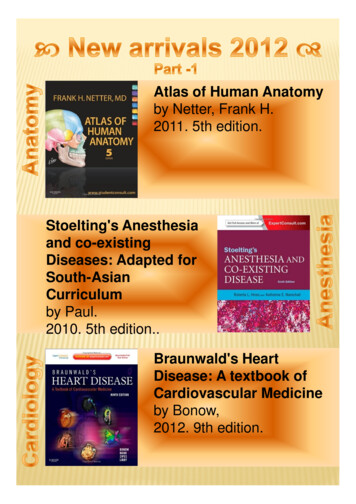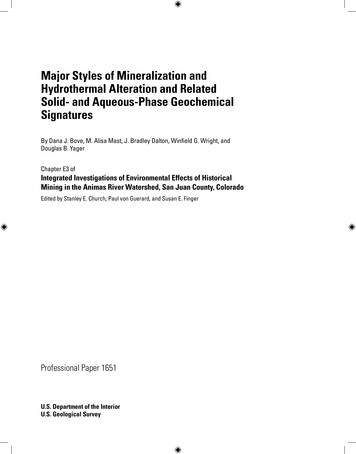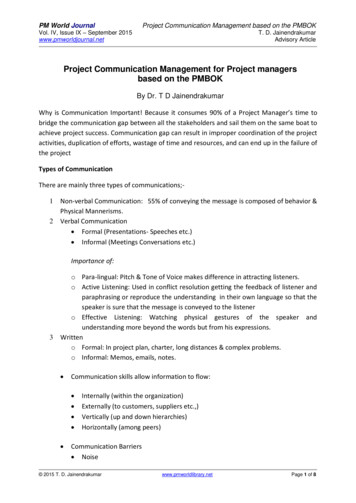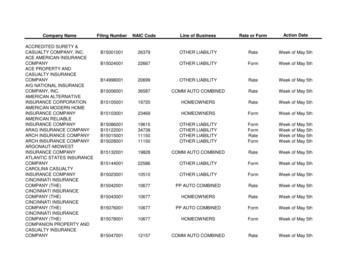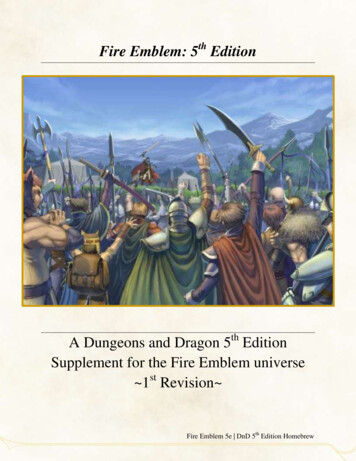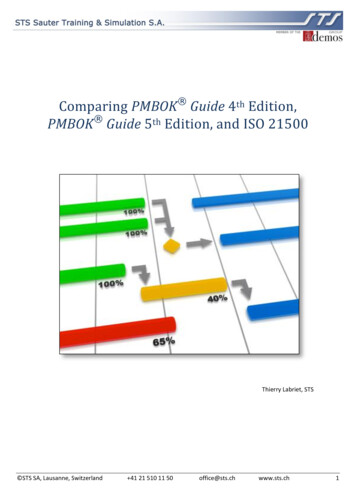
Transcription
Comparing PMBOK Guide 4th Edition,PMBOK Guide 5th Edition, and ISO 21500Thierry Labriet, STS STS SA, Lausanne, Switzerland 41 21 510 11 50office@sts.chwww.sts.ch1
Contents1Foreword . 32Executive summary . 43Process organization in the standards . 54Major changes on processes, in a nutshell. 95Detailed analysis . 105.1Project Integration Management . 105.2Project Scope Management . 135.3Project Time Management . 155.4Project Cost Management . 175.5Project Quality Management . 185.6Project Human Resource Management . 195.7Project Communications Management. 225.8Project Risk Management . 245.9Project Procurement Management. 265.10Project Stakeholder Management . 286Conclusion for the specialists . 297Management Conclusion. 30 STS SA, Lausanne, Switzerland 41 21 510 11 50office@sts.chwww.sts.ch2
1FOREWORDNational and international standards exist and initiated the emergence of project managementcertifications mostly targeting individuals, rather than organizations.Despite this orientation, most Project Management standards are process oriented. Therefore, manycompanies have developed in-house methodologies that are more or less inspired from thesestandards.Currently, three major process oriented certification bodies have a dominant and significantinfluence in Switzerland and Europe:The Project Management Institute (PMI) and its Project Management Body of Knowledge (PMBOK)guide . The Office of Government Commerce (OGC) and PRINCE2 , published in 1996, having beencontributed to by a consortium of some 150 European organizations. The Swiss Federal Strategy Unit for IT (FSUIT) the owner of the HERMES method.The International Project Management Association (IPMA) is not considered here since it is notprocess but competencies oriented, when considering its certification framework.In 2006, the British Standard Institute, a member of ISO, has initiated a request toward ISO to workon defining a standard for Project Management.ISO launched a new Technical Committee to deal with project management: TC 236. This committeeinvolves 37 participating countries and 14 observing countries.The TC236 secretariat has published guidance on project management: ISO Draft InternationalStandard (DIS) 21500, which is currently at approval stage.Since the PMBOK Guide has been approved by ANSI as American National Standards, and ANSIbeing the TC236 secretariat, some similarities were expected between the PMBOK Guide and theISO/DIS 21500 standard.This white paper aims to highlight the major communalities and differences between the ANSI andthe ISO standards, i.e. between the PMBOK Guide and the ISO/DIS 21500 standard.Both PMBOK Guides, 4th and 5th editions, have been considered and are covered in this white paper.Disclaimer: Both the ISO/DIS 21500 and PMBOK Guide 5th edition were being approved at the timewe wrote this document and minor changes may have been introduced in the final release of therespective documents. In the following document any reference to the ISO standard is related to theDraft International Standard, ISO/DIS 21500 document.“PMI”, “PMBOK”, “PMP” and “CAPM” are registered marks of Project Management Institute, Inc. STS SA, Lausanne, Switzerland 41 21 510 11 50office@sts.chwww.sts.ch3
2EXECUTIVE SUMMARYThe two releases of the PMBOK Guide and the ISO 21500 standards are very close. They present aset of processes that have been organized the same way, by project management stage and projectmanagement topic.The ISO standard is 47 pages only and is limited to the introduction of the processes, their inputs andtheir outputs.Both PMBOK Guides describe, through more than 450 pages, the project management processes,their inputs, their outputs and also the associated tools and techniques.In the chronological order, the ANSI standard came first, with the 4th edition of the PMBOK Guide.The ISO standard has been approved by the national committees and was released in August 2012.The new edition of the PMBOK Guide is expected by the end of 2012.ISO uses most of the PMBOK Guide 4th processes and introduced minor adaptations: the riskknowledge area has been revisited as well as the human resource management.The major change is related to stakeholder management; the subject group (aka knowledge area) hasbeen introduced by ISO and it appears as well in the new PMBOK Guide release. The two processesintroduced by ISO in this subject group were two processes of the communication knowledge area ofthe PMBOK Guide 4th edition.ISO processes are more likely oriented towards a cascade approach of the scope definition ratherthan an iterative approach. Therefore, the ISO standard is perhaps less attractive for Agile orientedorganizations. STS SA, Lausanne, Switzerland 41 21 510 11 50office@sts.chwww.sts.ch4
3PROCESS ORGANIZATION IN THE STANDARDSBoth standards (ANSI and ISO) are structured into project management stages (project management,not project stages or phases) and project management topics:PMBOK Guide 4th5 process groups9 knowledge areas42 processesStagesTopicsProcessesISO/DIS 215005 process groups10 subject groups39 processesPMBOK Guide 5th5 process groups10 knowledge areas47 processesNB: Since the PMBOK Guide 4th came first, we will use the wording “processgroups” and “knowledge areas” in this document.The first noticeable thing is the introduction of a new knowledge area in the DIS and the PMBOK Guide 5th edition: Stakeholder Management.PMBOK Guide 4thProcess g &Controlling5. ClosingKnowledge Areas uman ResourceCommunicationsRiskProcurementPMBOK Guide 5thISO/DIS ling5. ClosingInitiatingPlanningExecutingMonitoring &Controlling5. eTimeCostQualityHuman : In both PMBOK Guides, the full name of the knowledge areas follows thepattern Project KA Management : “Integration” is described by PMI as“Project Integration Management”. STS SA, Lausanne, Switzerland 41 21 510 11 50office@sts.chwww.sts.ch5
The set of processes exposed by the PMBOK Guide 4th edition is the following:PMBOK Guide 4thIntegrationInitiating4.1 Develop ProjectCharterPlanning4.2 Develop ProjectManagement PlanExecuting4.3 Direct and ManageProject ExecutionMonitoring &Controlling4.4 Monitor and ControlProject Work4.5 Perform IntegratedChange ControlScope5.1 Collect Requirements5.2 Define Scope5.3 Create WBS5.4 Verify Scope5.5 Control Scope6.6 Control ScheduleTime6.1 Define Activities6.2 Sequence Activities6.3 Estimate ActivityResources6.4 Estimate ActivityDurations6.5 Develop ScheduleCost7.1 Estimate Costs7.2 Determine Budget7.3 Control CostsQuality8.1 Plan Quality8.2 Perform QualityAssuranceHumanResources9.1 Develop HR Plan9.2 Acquire Project Team9.3 Develop Project Team9.4 Manage Project Team10.2 Plan Communications10.3 Distribute Information10.4 Manage StakeholdersExpectationsCommunications10.1 IdentifyStakeholdersRisk11.1 Plan Risk Management11.2 Identify Risks11.3 Perform QualitativeRisk Analysis11.4 Perform QuantitativeRisks Analysis11.5 Plan Risk ResponsesProcurement12.1 Plan Procurements STS SA, Lausanne, SwitzerlandClosing4.6 Close Project or Phase8.3 Perform Quality Control10.5 Report Performance11.6 Monitor and ControlRisks12.2 Conduct Procurements 41 21 510 11 5012.3 AdministerProcurementsoffice@sts.ch12.4 Close Procurementswww.sts.ch6
ISO presents the following set of processes*):ISO ning4.3.2 Develop ProjectCharter4.3.3 Develop Project Plans4.3.9 IdentifyStakeholdersImplementing4.3.4 Direct Project Work4.3.15 EstablishProject TeamResource4.3.5 Control Project Work4.3.6 Control Changes4.3.16 Estimate Resources4.3.17 Define ProjectOrganization4.3.18 Develop ProjectTeam4.3.19 Control Resources4.3.20 Manage ProjectTeam4.3.24 Control ScheduleTimeCost4.3.25 Estimate Costs4.3.26 Develop Budget4.3.27 Control CostsRisk4.3.28 Identify Risks4.3.29 Assess Risks4.3.30 Treat Risks4.3.31 Control RisksQuality4.3.32 Plan Quality4.3.33 Perform QualityAssurance4.3.34 Perform QualityControl4.3.35 Plan Procurements4.3.36 Select Suppliers4.3.37 Administer Contracts4.3.38 PlanCommunications4.3.39 DistributeInformation4.3.40 ManageCommunicationCommunications4.3.7 Close Project Phase orProject4.3.8 Collect LessonsLearned4.3.14 Control Scope4.3.21 Sequence Activities4.3.22 Estimate ActivityDurations4.3.23 Develop ScheduleProcurementClosing4.3.10 Manage Stakeholders4.3.11 Define Scope4.3.12 Create WBS4.3.13 Define ActivitiesScopeControlling*)This table is reproduced with the permission of ISO. ISO 25000:2012 can be obtained from any ISOmember and from ISO at www.iso.org. Copyright remains with ISO. STS SA, Lausanne, Switzerland 41 21 510 11 50office@sts.chwww.sts.ch7
The PMBOK Guide 5th edition introduces the following processes:PMBOK Guide 5thIntegrationInitiating4.1 Develop ProjectCharterPlanning4.2 Develop ProjectManagement PlanExecuting4.3 Direct and ManageProject ExecutionMonitoring &Controlling4.4 Monitor and ControlProject Work4.5 Perform IntegratedChange Control5.5 Validate Scope5.6 Control ScopeScope5.1 Plan ScopeManagement5.2 Collect Requirements5.3 Define Scope5.4 Create WBS6.7 Control ScheduleTime6.1 Plan ScheduleManagement6.2 Define Activities6.3 Sequence Activities6.4 Estimate ActivityResources6.5 Estimate ActivityDurations6.6 Develop Schedule7.1 Plan Cost Management7.2 Estimate Costs7.3 Determine Budget7.4 Control CostsCostQuality8.1 Plan QualityManagement8.2 Perform QualityAssuranceHumanResources9.1 Plan HR Management9.2 Acquire Project Team9.3 Develop Project Team9.4 Manage Project TeamCommunications10.1 Plan CommunicationsManagement10.2 ManageCommunicationsRisk11.1 Plan Risk Management11.2 Identify Risks11.3 Perform QualitativeRisk Analysis11.4 Perform QuantitativeRisks Analysis11.5 Plan Risk ResponsesProcurementStakeholder13.1 IdentifyStakeholders4.6 Close Project or Phase8.3 Control Quality10.3 ControlCommunications11.6 Control Risks12.1 Plan ProcurementManagement12.2 Conduct Procurements12.3 Control Procurements13.2 Plan StakeholderManagement13.3 Manage StakeholderEngagement13.4 Control StakeholderManagement STS SA, Lausanne, SwitzerlandClosing 41 21 510 11 50office@sts.ch12.4 Close Procurementswww.sts.ch8
4MAJOR CHANGES ON PROCESSES, IN A NUTSHELLThe PMBOK Guide 4th edition details 42 processes.From the PMBOK Guide 4th, ISO uses 32 processes or direct equivalents, revisits 2 processes (Develop HR plan and Acquire Project Team are revisited into EstablishProject Team and Define Project Organization). merges 2x2 processes into 2 (Perform Qualitative Risk Analysis and Perform QuantitativeRisk Analysis are merged into Assess Risks and Distribute Information and ReportPerformance are merged into Distribute Information) does not use 4 processes (Collect Requirements, Verify Scope, Plan Risk Management,Close Procurements) introduces 3 processes (Collect Lessons Learned, Control Resources, ManageCommunication)The ISO standard has 39 processes.The PMBOK Guide 5th, compared to its predecessor adds 4 processes to plan the management of knowledge areas introduces 2 new controlling processes (Control Communications & Control StakeholderManagement) merges 2 processes (Distribute Information and Report Performance) into a revisitedprocess (Manage Communications) reallocates 2 processes in the new stakeholder knowledge areaThis edition of the PMBOK Guide details 47 processes. STS SA, Lausanne, Switzerland 41 21 510 11 50office@sts.chwww.sts.ch9
5DETAILED ANALYSISFollowing the PMBOK Guide 4th edition structure, the major differences between the threereferences will be detailed, knowledge area by knowledge area.Since this structure didn’t include the stakeholder knowledge area, it will be detailed at the very endof this document.Therefore, the analysis will not strictly follow the ISO standard structure.5.1PROJECT INTEGRATION MANAGEMENTPMBOK Guide 4thprocessesISO/DIS 21500processesProcessDevelop ProjectCharterWhat’s new inISO?No major addition.What’s new inthe 5th edition?In addition to the expert judgment, the 5th edition proposes facilitationtechniques to build the project charter. These techniques have beenintroduced by the 5th edition. Typical facilitation techniques arebrainstorming, Delphi technique, problem solving, meetings, facilitation, etc.ProcessDevelop ProjectManagement PlanWhat’s new inISO?ISO reinforces the distinction between the baselines and the managementplans.The Project Management Plan federates the management plans of thedifferent knowledge areas, like the scope management plan, the riskmanagement plan, etc., that are called subsidiary plans.The project plan contains the baselines of the project, in terms of scope,schedule, resources, risks, etc.What’s new inthe 5th edition?For both frameworks of PMI, the Project Management Plan integrates andconsolidates all of the subsidiary management plans and baselines.Thus, the Project Management Plan is made of the two major sections: Thesubsidiary management plans and the baselines. This is consistent with theprevious edition. STS SA, Lausanne, Switzerland 41 21 510 11 50Develop ProjectCharterPMBOK Guide 5thprocessesDevelop ProjectPlansoffice@sts.chDevelop ProjectCharterDevelop ProjectManagement Planwww.sts.ch10
PMBOK Guide 4thprocessesProcessDirect and ManageProject ExecutionISO/DIS 21500processesDirect Project WorkPMBOK Guide 5thprocessesDirect and ManageProject ExecutionChange requests are not an input of the “Direct Project Work” process. ANSIjustifies such changes because when the work is being done, teammates mayrequest process adaptations, discover new way to perform, etc.What’s new inISO?ISO introduces more significantly the issue log in its standard. It is a cleardeliverable that flows between processes when it is a component of theproject documentation for ANSI. The issue log is put at the same level thanthe risk register in the ISO standard.What’s new inthe 5th edition?Meetings (and not facilitation techniques(!?)) are introduced as a techniqueto manage the project execution. These meetings might trigger the creationof a change request when dealing with scope change proposals, processadaptations, etc.ProcessMonitor and ControlProject WorkWhat’s new inISO?For ISO, this process is in charge of the transformation of progress data intoprogress reports and forecasts. In the ANSI standard, this transformationoccurs in the “Report Performance” process, which is also a controllingprocess.ISO introduces also “Project Handover Reports” but doesn’t detail its use.What’s new inthe 5th edition?The new edition of the ANSI standard goes into the same direction than ISO:The forecasts and the work performance information are analyzed in thisprocess to produce performance reports.ProcessPerform IntegratedChange ControlWhat’s new inISO?ISO uses more formally a change register, when it is a de facto document inthe ANSI standard.What’s new inthe 5th edition?The change register is also more formal, with the name of a change log.“Change Control Tools” are introduced by the 5th edition in order to facilitateconfiguration and change management. STS SA, Lausanne, Switzerland 41 21 510 11 50Control Project WorkControl Changesoffice@sts.chMonitor and ControlProject WorkPerform IntegratedChange Controlwww.sts.ch11
PMBOK Guide 4thprocessesISO/DIS 21500processesClose Project Phaseor ProjectPMBOK Guide 5thprocessesProcessClose Project orPhaseClose Project orPhaseWhat’s new inISO?The closure report and released resources are explicit outputs of the ISOprocess, which is a clear improvement.ISO uses the project handover reports and certificates as formal inputs toconfirm the well production of expected deliverables with the expected levelof quality.What’s new inthe 5th edition?The 5th edition doesn’t confirm the explicit use of the closure report andreleased resources.It stays very close to the 4th edition with the addition of analytical techniquesand meetings as tools and techniques.Collect LessonsLearnedProcessWhat’s new inISO?This process has been introduced by ISO. It is a clear sign of the importance ofknowledge management in learning organization even though it is notmanaged as a new knowledge area, as expected by many contributors.This process involves many situational outputs of other processes to producea lessons learned document.What’s new inthe 5th edition?This process has not been implemented in the ANSI standard, yet. On theother hand, many process outputs now include “Lessons LearnedDocumentation” in the “Organizational Process Assets Updates” generaldeliverable. STS SA, Lausanne, Switzerland 41 21 510 11 50office@sts.chwww.sts.ch12
5.2PROJECT SCOPE MANAGEMENTPMBOK Guide 4thprocessesISO/DIS 21500processesPlan ScopeManagementProcessWhat’s new inthe 5th edition?PMBOK Guide 5thprocessesThe new edition of the ANSI standard implements systematically amanagement plan for each knowledge area. It was an unclear area in theprevious edition: The scope management plan was not covered in any processbut mentioned as a subsidiary plan of the project management plan, forinstance.This new process has major outputs: The scope management plan that detailshow the scope will be managed and what templates will be used.The requirement management plan is also very interesting since it details howthe requirements will be managed from the start until the end and how theconfiguration management activities will be handled.ProcessCollect RequirementsWhat’s new inthe 5th edition?The 5th edition has removed the inconsistent output of the “CollectRequirements” process which is the requirements management plan.ProcessDefine ScopeWhat’s new inISO?ISO puts in this process the creation of the requirements documentation andmakes an interesting link between the scope and its contribution to thestrategic goals of the company.What’s new inthe 5th edition?No major addition. STS SA, Lausanne, Switzerland 41 21 510 11 50Collect RequirementsDefine Scopeoffice@sts.chDefine Scopewww.sts.ch13
PMBOK Guide 4thprocessesISO/DIS 21500processesProcessCreate WBSWhat’s new inISO?No major addition.What’s new inthe 5th edition?Whereas ISO shows the WBS and its dictionary as the sole outputs of theprocess, the new edition of the ANSI standard keeps the term of scopebaseline.This is consistent with other knowledge areas: For instance, regarding time,the planning processes issue a schedule baseline, not one specific instance ofsuch a baseline like a Gantt, a Pert, etc.The 4th edition had both outputs: A scope baseline, the WBS and its dictionarywhich was somehow redundant.ProcessCreate WBSPMBOK Guide 5thprocessesCreate WBSDefine ActivitiesWhat’s new inISO?This process has been moved by ISO in scope management. Detailed changesare showed in the next knowledge area.ProcessVerify ScopeWhat’s new inthe 5th edition?The 5th edition introduces an interesting points regarding the validation(instead of verification) of the scope:The acceptance of the deliverable is not made just upon the scope baselinebut also on work performance data that includes the degree of compliancewith requirements, the number of nonconformities and the severity of thenonconformities.This involves the validation to be made using group decision-makingtechniques.ProcessControl ScopeWhat’s new inISO?No major addition.What’s new inthe 5th edition?No major addition. STS SA, Lausanne, Switzerland 41 21 510 11 50Validate ScopeControl Scopeoffice@sts.chControl Scopewww.sts.ch14
5.3PROJECT TIME MANAGEMENTPMBOK Guide 4thprocessesISO/DIS 21500processesPMBOK Guide 5thprocessesPlan ScheduleManagementProcessWhat’s new inthe 5th edition?This new process details how time-related activities will be managed throughthe planning, the execution, the control and the closure of the project orphase.ProcessDefine ActivitiesWhat’s new inISO?Except the fact this process is listed in the scope subject group, there is nomajor change compared to the ANSI standard.What’s new inthe 5th edition?No major addition.ProcessSequence ActivitiesWhat’s new inISO?No major addition.What’s new inthe 5th edition?No major addition.ProcessEstimate ActivityResourcesWhat’s new inISO?ISO has moved this process in the Resource subject group. The process“Estimate Resources” deals with all kind of resources (like the ANSI standard)but since ISO put it in the Resource subject group, this group couldn’t be “HRonly” anymore.What’s new inthe 5th edition?Activity cost estimate and risk register have been added in the list of inputs ofthe 4th edition since risks and costs may impact resource selection. STS SA, Lausanne, Switzerland 41 21 510 11 50Define ActivitiesDefine ActivitiesSequence ActivitiesSequence ActivitiesEstimate ResourcesEstimate ActivityResourcesoffice@sts.chwww.sts.ch15
PMBOK Guide 4thprocessesISO/DIS 21500processesPMBOK Guide 5thprocessesProcessEstimate ActivityDurationsEstimate ActivityDurationsEstimate ActivityDurationsWhat’s new inISO?No major addition.What’s new inthe 5th edition?The new edition of the ANSI standard adds the risk register as an input toestimating activity durations. This is interesting since there is a balance to findbetween 1) identifying and managing risks as such and removing uncertaintyfrom the estimates and 2) keeping minor uncertainties in the responsibility ofthe team member, and therefore in the duration estimate, because theamount at stake is far minor than the cost of managing the risk.ProcessDevelop ScheduleWhat’s new inISO?ISO introduces schedule constraints as an input of the schedule developmentwhich is making sense: Such information might impose deadlines (constrainedmilestones) to the schedule development.What’s new inthe 5th edition?The figure 6-17 related to the Critical Path Method gives a better view on howto compute early starts and finishes of the activities through the networkdiagram, according to their dependencies.It also depicts more in-depth the Critical Chain Method that is more and moreused in project management.A new technique of resource optimization has been added: ResourceSmoothing has the same intend that Resource Leveling except that it is keptwithin the activity float, so the project critical path is not changed.ProcessControl ScheduleWhat’s new inISO?ISO, in the process description, puts the emphasis on the necessity to produceschedule forecasts, in order to trigger change requests, if required.What’s new inthe 5th edition?The new edition adds the schedule forecasts as outputs of this controllingprocess. STS SA, Lausanne, Switzerland 41 21 510 11 50Develop ScheduleControl Scheduleoffice@sts.chDevelop ScheduleControl Schedulewww.sts.ch16
5.4PROJECT COST MANAGEMENTPMBOK Guide 4thprocessesISO/DIS 21500processesPMBOK Guide 5thprocessesPlan CostManagementProcessWhat’s new inthe 5th edition?Like other management plan, this one has been added to cover the cost area.In the cost management plan are defined the control thresholds and the rulesto be applied when using performance measures like EVM does.ProcessEstimate CostsWhat’s new inISO?No major addition.What’s new inthe 5th edition?No major addition. There is a minor point regarding weighted average of costestimates: In addition to the PERT estimates, the new ANSI standard present asimple average (C M P)/3.ProcessDetermine BudgetWhat’s new inISO?The ISO standard doesn’t show evidence that the determined budget is timebased and can be used to determine funding requirements.What’s new inthe 5th edition?The new edition of the ANSI standard clarifies the inclusion of the contingencyreserve in the cost baseline and the exclusion of the management reserve.This last reserve is part of the overall budget and the funding requirements.Regarding the contingency reserve, a new figure shows the understanding ofPMI: An activity level and an overall contingency reserve are shown. Thismight indicate that risks and their associated reserve are managed at thework package level, not necessarily at the activity level.ProcessControl CostsWhat’s new inISO?No major addition.What’s new inthe 5th edition?Estimate CostsDevelop BudgetControl CostsEstimate CostsDetermine BudgetControl CostsThe 5th edition indicates reserve analysis as a new technique. This answers theneeds of project managers managing projects by risks. STS SA, Lausanne, Switzerland 41 21 510 11 50office@sts.chwww.sts.ch17
5.5PROJECT QUALITY MANAGEMENTPMBOK Guide 4thprocessesProcessPlan QualityISO/DIS 21500processesPlan QualityPMBOK Guide 5thprocessesPlan QualityManagementWhat’s new inISO?ISO indicates the quality plan as an output of this process. This plan is a set ofdocuments ensuring that the quality standards will be met. It seems that thiscovers the multiple outputs of the ANSI standard (quality metrics, qualitychecklists, process improvement plan, etc.).The quality management plan refers to the quality policy set by thepermanent organization (or derived from it).What’s new inthe 5th edition?The new edition introduces new tools (“Seven basics quality tools”: cause &effect diagrams, flowcharts, check sheets, Pareto diagrams, histograms,control charts and scatter diagrams) and removed flowcharting andproprietary quality management methodologies.ProcessPerform QualityAssuranceWhat’s new inISO?In the ISO standard, quality assurance is mostly concerned with the assurancethat quality requirements are communicated and understood, and thatestablished procedures are used.It says also that “quality assurance activities ensure that * product qualityconform to project quality requirements and standards” which is a concernmostly address in the Quality Control process of the ANSI standard.What’s new inthe 5th edition?Quality Management and Control Tools are more detailed than in theprevious edition.ProcessPerform QualityControlWhat’s new inISO?Formal inspection reports are mentioned as key outputs.What’s new inthe 5th edition?No major addition. STS SA, Lausanne, Switzerland 41 21 510 11 50Perform QualityAssurancePerform QualityControloffice@sts.chPerform QualityAssurancePerform QualityControlwww.sts.ch18
5.6PROJECT HUMAN RESOURCE MANAGEMENTThis knowledge area is presented differently in the two standards and we need to take few minutesto understand the two points of view.In both ANSI standards, the first process is “Develop HR Plan” (or “Plan HR Management” in the 5thedition). This process is in the planning process group. Other HR processes are execution processes:“Acquire Project Team”, “Develop Project Team” and “Manage Project Team”.In the ISO standard, we can see that there is a first process “Establish Project Team” that appears inthe Initiating process group.Then follow the planning processes “Estimate Resources” and “Define Project Organization”.The “Develop Project Team” is an execution process and we have two controlling processes “ControlResources and “Manage Project Team”.Gosh! The two standards have a completely different point of views! Not really!ISO puts the process “Establish Project Team” in the Initiating process group because it is seen as aprocess that is performed continuously throughout the project.ISO doesn’t mean that the team is built first, then resources are estimated and last the team isorganized.When one looks at the inputs and outputs of this process, it is very close to the ANSI standard pointof view and corresponds to the “Acquire Project Team” process.Let’s represent this graphically: STS SA, Lausanne, Switzerland 41 21 510 11 50office@sts.chwww.sts.ch19
ISO answers this way to a concern: the project needs a team to perform the initiating and planningactivities. So this process can be performed iteratively, and the main team set-up occurs in theplanning.PMBOK Guide 4thprocessesProcessWhat’s new inISO?What’s new inthe 5th edition?ProcessDevelop HR PlanISO/DIS 21500processesDefine ProjectOrganizationPMBOK Guide 5thprocessesPlan HR ManagementThe “Define Project Organization” process aims to secure commitments fromthe permanent organization (team leaders for instance). Like the “Develop HRPlan”, its objective is also to
The Project Management Institute (PMI) and its Project Management Body of Knowledge (PMBOK) guide . The Office of Government Commerce (OGC) and PRINCE2 , published in 1996, having been contributed to by a consortium of some 150 European organizations. The Swiss Federal Str
